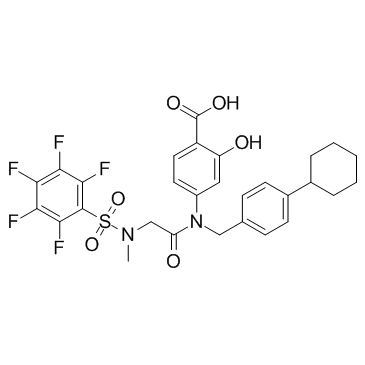1334493-07-0
| Name | 4-[(4-Cyclohexylbenzyl){N-methyl-N-[(pentafluorophenyl)sulfonyl]glycyl}amino]-2-hydroxybenzoic acid |
|---|---|
| Synonyms |
4-[(4-Cyclohexylbenzyl){N-methyl-N-[(pentafluorophenyl)sulfonyl]glycyl}amino]-2-hydroxybenzoic acid
Benzoic acid, 4-[[(4-cyclohexylphenyl)methyl][2-[methyl[(2,3,4,5,6-pentafluorophenyl)sulfonyl]amino]acetyl]amino]-2-hydroxy- BP-1-102 STAT3 Inhibitor XVIII |
| Description | BP-1-102 is an orally available, small-molecule inhibitor of transcription factor Stat3, with an IC50 of 6.8 μM. |
|---|---|
| Related Catalog | |
| Target |
STAT3:6.8 μM (IC50) |
| In Vitro | BP-1-102 binds Stat3 with an affinity KD of 504 nM. BP-1-102 inhibits Stat3 DNA-binding activity in vitro, with an IC50 value of 6.8±0.8 μM. It blocks Stat3-phospho-tyrosine peptide interactions and Stat3 activation at 4-6.8 μM, and selectively inhibits growth, survival, migration, and invasion of Stat3-dependent tumor cells. BP-1-102-mediated inhibition of aberrantly active Stat3 in tumor cells suppresses the expression of c-Myc, Cyclin D1, Bcl-xL, Survivin, VEGF, and Krüppel-like factor 8[1]. |
| In Vivo | Mice therapeutically given BP-1-102, an orally bioavailable compound targeting STAT3/NF-kB activation and cross-talk, exhibit reduced colon tumorigenesis and diminished expression of STAT3/NF-kB-activating cytokines in the neoplastic areas[2]. BP-1-102 is orally bioavailable and that the agent accumulates in tumor tissues at levels sufficient to inhibit aberrantly active Stat3 functions and inhibit tumor growth[1]. |
| Cell Assay | Proliferating cells in 6- or 96-well plates are treated once with 0-30 μM BP-1-102 for 24 h or with 10 μM BP-1-102 for up to 96 h. Viable cells are counted by trypan blue exclusion/phase-contrast microscopy or assessed by a cell proliferation kit[1]. |
| Animal Admin | Mice: Athymic nude mice with established tumors are grouped and then given BP-1-102 (in 0.05% DMSO in water) at 1 or 3mg/kg (i.v.) every 2 or every 3 d or 3 mg/kg (oral gavage, 100 μL) every day for 15 or 20 d. Animals are monitored every day, and tumor sizes are measured with calipers and body weights are taken every 2 or 3 d. For each treatment group, the tumor volumes for each set of measurements are statistically analyzed in comparison with the control group using a paired T test[1]. |
| References |
| Density | 1.5±0.1 g/cm3 |
|---|---|
| Boiling Point | 749.2±70.0 °C at 760 mmHg |
| Molecular Formula | C29H27F5N2O6S |
| Molecular Weight | 626.591 |
| Flash Point | 406.9±35.7 °C |
| Exact Mass | 626.151001 |
| LogP | 7.77 |
| Vapour Pressure | 0.0±2.6 mmHg at 25°C |
| Index of Refraction | 1.601 |
| Storage condition | -20℃ |
